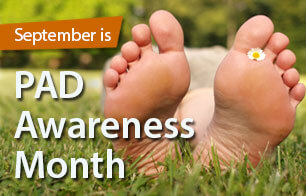
Peripheral arterial disease (PAD) is a serious, underdiagnosed disease that is similar to coronary artery disease. Both develop when cholesterol levels and scar tissue build up, causing the arteries to narrow and restrict blood flow. The difference is that PAD affects arteries outside the heart.
Untreated, PAD can lead to difficulty in walking and, in its most severe stage, gangrene, leading to leg amputation. Also, people who have PAD often have arterial blockages in other parts of the body and are therefore at greater risk of suffering a heart attack or stroke.
Here are 10 facts about PAD:
1. PAD affects 12-14% of the world’s population.
2. PAD affects six times more people worldwide than HIV.
3. Eight million Americans suffer from PAD.
4. PAD affects 20% of patients over age 75.
5. One in three diabetics over age 50 suffer from PAD.
6. Smoking increases the likelihood of developing PAD by 400%.
7. Each year, approximately 150,000 lower-limb amputations in the U.S. can be attributed to PAD.
9. Only 50% of PAD amputees survive more than four years.
10. About 20-50% of people with PAD are asymptomatic.
KNOW YOUR ABI!
If you have one or more risk factors, including smoking, diabetes, obesity, high blood pressure, high cholesterol, or family history, visit your doctor to request an ankle-brachial index (ABI) test. The ABI is a simple test that compares the blood pressure of the arms and legs to determine if blood flow is restricted.
Learn more about PAD at the National Institutes of Health website.
MORE ON PAD AWARENESS MONTH
U.S. trends in diabetes and obesity
What is peripheral arterial disease?